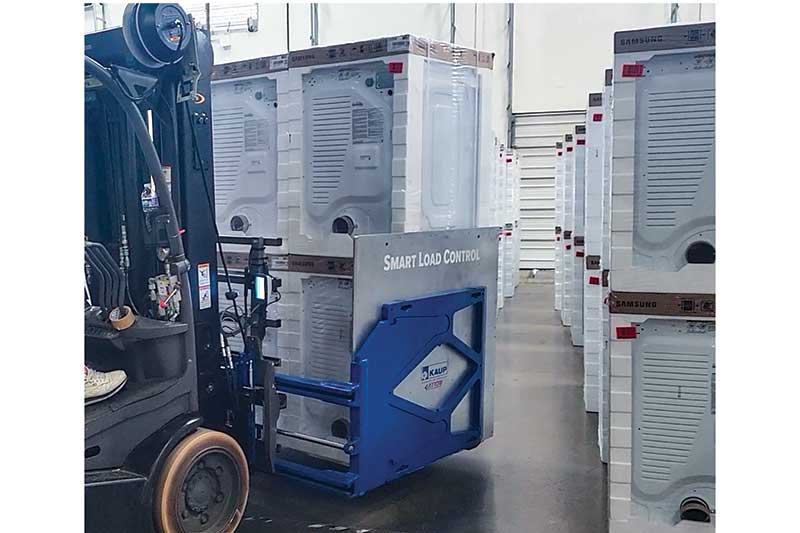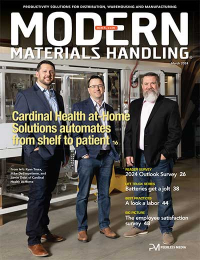Sensor-enabled lift truck attachments as time savers
Essential attachments like clamps are leveraging built-in sensors to save time for operators while protecting from incidents or product damage.

Attachments are an essential part of efficient and safe lift truck workflows. While the basic types of attachments needed have been around for many years, the technology used in attachments has become smarter and more sensor-based in recent years, including embedded cameras on forks and other sensors that help make attachments easier to use, and in the process, can save time for operators.
Take the type of clamp attachment used to move white goods like refrigerators. Traditional clamps might need to be calibrated or adjusted by an operator prior to moving goods, but a new sensor-based clamp from KAUP makes the attachment self-adjusting, even while on the move over different surfaces, says Kevin Estes, product manager with Arrow Attachments, KAUP’s U.S.-based distributor.
The smart attachment, KAUP’s Smart Load Control (SLC) clamp, uses on-the-clamp sensing that ensures the clamp remains precisely calibrated for each unique transport task, even over changes in terrain, says Estes. It’s a significant time saver for operators, he adds, because there is no fiddling with pressure adjustments—once the SLC’s display light shows green, the load can be moved safely at the correct clamping force. The SLC clamp will also log the pressures used in each operation, but the key benefit is time.
“There’s no input or selection required from the operator ever,” Estes says. “The clamp will automatically and continually apply the minimum amount of pressure required to not only lift the load, but also transport over changing surfaces or terrain. So, the clamp will continually adjust, increasing and decreasing pressure as the truck travels and is perhaps hitting bumps, or going in and out of trailers at dock positions.”
Estes says smart sensor technology for attachments has advanced because of technology first developed for automatic guided vehicle (AGV) attachments, but now sensors are filtering into attachments that can be used with manually operated trucks.
“The two main benefits we see a product like the SLC is that No. 1, it keeps products damage free, but also it’s a real time saver for the operators because they no longer have to make selections or be concerned about feathering the clamp pressure as they pick a load up.”
Clark Jordan, a vice president with attachments company Cascade Corp., says Cascade is using sensors on its attachments for multiple functions, such as opening and closing positions, rotational positions, or tilt, as well as using sensors to govern clamp force, arm speed and rotational speed. “Cascade’s entire product line is being sensorized as per customers’ needs for their specific materials handling requirements,” Jordan says.
Camera- and sensor-enabled forks are also popular when working at heights to safely speed up work, notes Jordan. “Allowing the driver to have clear visibility of the loads and the pallet entry points are extremely beneficial in reducing not only pallet damage, but product damage as well,” he says. “Further, we have noticed that drivers can read product labels at elevated lift heights, allowing them to find the correct load without having to pick the load, lower it and then read labels.”

Article Topics
Arrow Material Handling Products News & Resources
Sensor-enabled lift truck attachments as time saversLatest in Materials Handling
Geek+ and System Teknik deploy PopPick solution for pharmacy group Med24.dk Beckhoff USA opens new office in Austin, Texas Manhattan Associates selects TeamViewer as partner for warehouse vision picking ASME Foundation wins grant for technical workforce development The (Not So) Secret Weapons: How Key Cabinets and Asset Management Lockers Are Changing Supply Chain Operations MODEX C-Suite Interview with Harold Vanasse: The perfect blend of automation and sustainability Consultant and industry leader John M. Hill passes on at age 86 More Materials HandlingAbout the Author
Subscribe to Materials Handling Magazine

Find out what the world's most innovative companies are doing to improve productivity in their plants and distribution centers.
Start your FREE subscription today.
April 2024 Modern Materials Handling

Latest Resources











